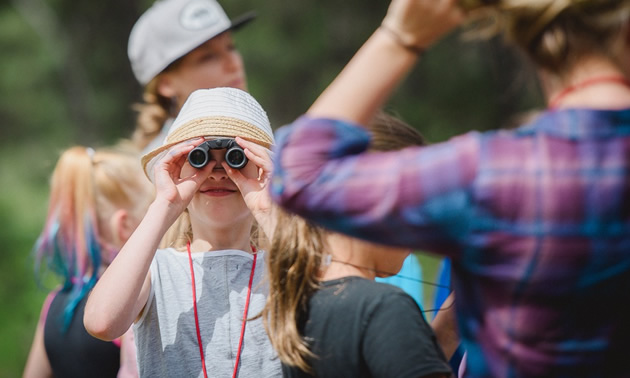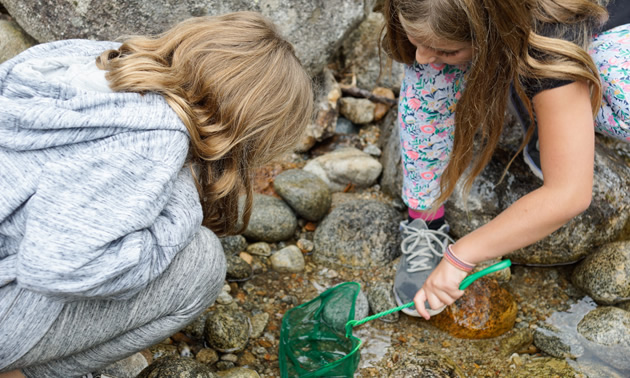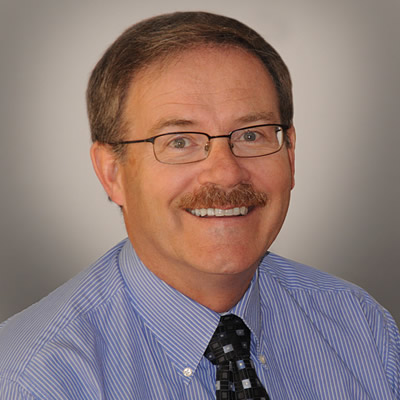Students “Do and Learn” in their wild backyards
The Trust is committing over $1.3 million over the next three years to environmental education programs in the region

Environmental education inspires awareness and stewardship of our natural environment. — Photo courtesy Columbia Basin Trust
With patches of snow on the ground, it’s a day for jackets and hoods up to protect ears from the cold. It’s Wednesday, November 14, 2018, and a group of ninth graders is traipsing across an abandoned hay field outside Cranbrook with loppers and shovels in hand. The kids have taken tree cuttings, known as live stakes—of willow, cottonwood and more—and are planting some now and leaving some to plant next spring. The goal: to help restore the field into a functioning wetland.
This group is doing its final project after participating in Know Your Watershed, an environmental education program Columbia Basin Trust developed in partnership with Wildsight. Not only are the students learning what makes a healthy watershed—one of the program’s goals—but the tree-planting day also ties into what they’ve been studying in biology class.
This is the fifth year teacher Dawn Hildebrandt has taken advantage of the free program for her students—and she says the students are always overwhelmingly positive about the experience.
“Over the years, when we get back together in the classroom, almost every kid has something to say, because they actually participated in everything. It’s not a watch and learn—it’s a do and learn.”
Renewed Partnerships
To increase opportunities like these, the Trust is renewing its commitment to environmental education programs in the region, with nearly $1.3 million over the next three years. It’s one of the ways the Trust is delivering on its Environment Strategic Plan goal to engage Basin residents in learning about the Basin’s diverse landscapes, waterways and ecosystems, and how to care for them.
“We’re partnering with the Columbia Basin Environmental Education Network and Wildsight to engage students through in-class studies, outdoor experiences and in-depth projects to build their personal connections with nature,” said Johnny Strilaeff, Trust President and Chief Executive Officer. “The more that Columbia Basin residents of all ages know about the outdoors and spend time in it, the more they will take care of it now and in the future.”
The funding will support three things. First is the Trust’s Know Your Watershed program, delivered by Wildsight, which helps grade nine students in the Basin understand where their water comes from, how it is used and where it goes after it’s used. Last school year alone, this program reached 1,300 students.

Students dip-netting for bugs — Photo courtesy Columbia Basin Trust
Second are the four Education in the Wild programs run by Wildsight, which teach about 3,600 students a year about the ecology of their “wild backyards.” Activities include dip-netting for bugs, discovering the web of life on the forest floor, examining snow crystals and following animal tracks in the snow.
Third is the Columbia Basin Environmental Education Network (CBEEN), which encourages environmental stewardship and sustainability in the Basin by supporting environmental educators. In the past year alone, CBEEN has provided a variety of training opportunities and resources to 750 educators. CBEEN also runs the Wild Voices for Kids program, which teaches about 5,000 students a year about the environment, natural history and culture of the Basin.
Inspired
Laura Jackman teaches second and third graders at Rossland Summit School. She’s been accessing Wild Voices for Kids for years—and also other resources that CBEEN offers. In fact, she and four other teachers in her school were so inspired at CBEEN’s leadership clinic that they’ve committed to taking their students out of the classroom one day a week to engage with either the community or the natural environment.
“I’m a really strong believer that when kids know the names of the flora and fauna that live in their place, they’ll be more likely to protect them in the future and become stewards of the environment,” she says. But not every teacher has the expertise to provide these experiences themselves. That’s where outside environmental educators and programs like Wild Voices are important. “They really provide a connection for the students by giving the environmental knowledge and context,” she says. They enable teachers to go beyond the direct outdoors right around them and expand the education they offer students.
Sonja Seher manages Wild Voices for Kids. “Some students may have never visited a field site or connected with mentors other than their teachers or parents,” she says. “An experience like this can really build their world and deepen their connection to place. For older or more experienced students, a Wild Voices program could get them to look at a familiar landscape through a different lens, ask deeper or more specific questions and consider themselves—and their role—within an ecosystem.”
As for Jackman, she now provides this education to her own students—“because of CBEEN essentially,” she says. “It inspired me so much that I went out and I looked for the background information and now I’m providing that education for my students.”
She also mentors other teachers in environmental education. She has helped form an association of environmental educators in her school district, which provides opportunities for professional development. And she helps run Rossland’s BioBlitz, which brings together about 450 students from all of the community’s schools to learn about the environment.
Impactful
The students benefit—along with other community members for programs and events that extend beyond schools—but what are the greater impacts?
Lindsay Cuff is Wildsight’s Communications and Development Manager. She says their programs “instill a sense of connection and place, and give students the tools to face the challenges of sustainability with knowledge and inspiration. Research shows that if we develop a strong connection to the natural world as children, we are more likely to cherish and try to protect it as adults.”
CBEEN’s Executive Director, Duncan Whittick, says, “The overall benefit is that we will all enjoy healthier and more resilient communities to live in. We will also better understand our local natural environment and become more empowered to take steps to support and sustain healthier ecosystems, which in turn support human health.”
After speaking enthusiastically about the tree-planting experience, Hildebrandt lists two important effects. “One, we’ve actually done something, like planting the trees. Second, the social responsibility: the kids are seeing that, ‘Hey, no one else is responsible to do this. I’m responsible to do this. And if we don’t do it, who’s going to do it?’ I love it.”





Comments